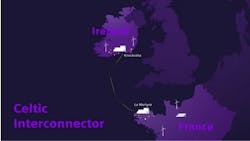Siemens Energy Connects Irish Power Grid with Continental Europe for the First Time
Siemens Energy will deliver the high-voltage direct current (HVDC) transmission technology for the Celtic Interconnector, an electricity highway between France and Ireland. It will be the first connection between the Irish grid and Continental Europe. The project will strengthen the security of electricity supply in both countries and facilitate the integration of renewable energy sources into the European electricity grid. The order value for Siemens Energy is in the mid three-digit million-euro range. The interconnector is jointly developed by EirGrid, the electricity transmission system operator in Ireland, and its French counterpart, RTE.
Celtic Interconnector has a total length of 575 km, of which 500 km of cables will run through the Celtic Sea. Over such long distances, electricity can only be economically transported in the form of direct current. Siemens Energy is therefore building two converter stations at the end points of the interconnector — one near Knockraha, located in the County Cork region of Ireland, the other one near La Martyre in France.
Both can convert alternating current, as fed into the stations from the respective national grid, into direct current for transportation, and vice versa. In this way, the converter stations enable the bidirectional exchange of up to 700 MW of electricity. This corresponds to the supply of around 450,000 households. In the future, Ireland will be able to import French electricity to secure base load in the grid or — after implementation of its ambitious wind energy plans - send excess renewable energy to Europe. Energization of Celtic Interconnector is scheduled for 2026.
“We absolutely cannot afford to waste electricity from renewable energy sources. Every spare electron of renewable energy that can be shared with others brings us closer to our climate goals,” says Tim Holt, member of the executive board, Siemens Energy. “The increasing interconnection of European electricity grids enables consumers to benefit from a more open electricity market, higher energy security and lower electricity costs. It demonstrates that only together we can manage the energy triangle of affordability, reliability, and security.”
HVDC technology plays a decisive role in the changing European energy landscape: electricity links between neighboring countries lower the risk of blackouts and facilitate the handling of variable renewable power sources like solar and wind. Working towards a carbon-free Europe, the EU has set a target that each country should aim for an electrical interconnection capacity of at least 15% of its installed production by 2030, provided that the welfare cost-benefit analysis of each new investment remains profitable in the public interest. In 2021, 16 countries reported being on track to reach that target by 2030 or have already reached it.
